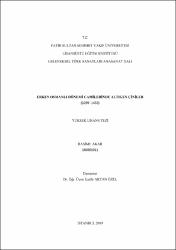Erken Osmanlı Dönemi Camilerinde Altıgen Çiniler (1299-1453)
Künye
AKAR, Rasime, Erken Osmanlı Dönemi Camilerinde Altıgen Çiniler (1299-1453), Fatih Sultan Mehmet Vakıf Üniversitesi Lisansüstü Eğitim Enstitüsü Geleneksel Türk Sanatları Anasanat Dalı, Yayımlanmamış Yüksek Lisans Tezi, 2019.Özet
Erken Osmanlı Dönemi, gerek mimari gerekse mimaride kullanılan süsleme unsurları açısından bazı farklılaşmaların yaşandığı bir dönemdir. Osmanlı Devleti’nin yaşadığı siyasal ve ekonomik gelişmeler devletin sosyal yapısını etkilemiş olup bu etkileşim sanat anlayışında da bir farklılaşmaya neden olmuştur. “ Erken Osmanlı Dönemi Camilerinde Altıgen Çiniler (1299-1453)” başlıklı tez çalışmasında, Osmanlı Beyliği’nin kuruluşundan, İstanbul’un fethine kadarki dönemde inşa edilmiş camilerin çini süslemelerine malzeme, teknik, motif ve kompozisyon açısından ayrıntılı biçimde tanıtmak ve Türk Çini Sanatı’ndaki yerini belirtmek amaçlanmıştır. geometrik kompozisyonlarla ilgili son dönemlerde gerçekleştirilen çalışmalar daha çok ahşap ve taş malzeme üzerine yürütülmüştür. Çini sanatındaki geometrik formlar üzerinde bir çalışma yapılmamıştır. Tez çalışması üç bölümden oluşmakta olup birinci bölümde Erken Osmanlı Devleti’nin genel özelliklerine değinilmiştir. İkinci bölümde geometri ve sanat arasındaki ilişkiye yer verilmiş olup sanat açısından altın oranın önemine değinilmiş, Erken Osmanlı Dönemi Çini Sanatı’nda kullanılan geometrik formlu levhalara yer verilmiştir. Üçüncü bölümde ise erken dönemde inşa edilmiş camilerde altıgen formlardaki levhalar tespit edilip; oluşturulan kompozisyonların detaylı analizi yapılmıştır, çizimlerle desteklenmiştir. Araştırma konusunu oluşturan çinilerin kullanıldığı yapılar, erken dönemin merkezleri olan İznik, Bursa, Edirne’de yer almaktadırlar. Mozaik tekniği ile yapılmış çiniler başlıca bir araştırma konusu olacağından kapsam dışında bırakılmış detaylı açıklamaya gidilmemiştir. Değerlendirme ve sonuç bölümünde tez çalışmasının genel değerlendirmesi yapılmıştır. Early Ottoman period is a time in which some differentiation is experienced in architecture, and the decoration elements used in it. The political and economic developments experienced by the Ottoman Empire affected the social structure of the state and this interaction caused a differentiation in the concept of art. In the thesis “The Geometrical Design in the Early Ottoman Period Tiled Mosques (1299-1453)”, the ornaments of the mosques built in the period from the foundation of the Ottoman Principality to the conquest of Istanbul were introduced in terms of material, technique, motif and composition. This thesis aims to evaluate the importance of these ornaments in Turkish Tile Art. The most recent studies on geometric compositions have been carried out on wood and stone materials, and there is no study on geometric forms in tile art. The thesis consists of three parts, and in the first chapter the general characteristics of the early Ottoman Empire are mentioned. The relationship between art and the importance of the golden ratio in art is mentioned, and geometric form plates used in the Early Ottoman Tile Art were analyzed. In the early period mosques, geometric forms were identified and detailed analysis of the compositions were made supported by drawings. Although the works discussed in the catalog of the research subject were limited to 1453, some of the advanced works, which were observed to be continued in the style of Early Ottoman style in the art of tile, were supported by visuals. Structures using the tiles that constitute the subject of this research are located in Iznik, Bursa, Edirne with centers in the early period. Since the tiles made with mosaic technique would have been a major research topic, they were excluded from the research, and no detailed explanation were made . In the evaluation and conclusion section, the general evaluation of the thesis work was done.



















